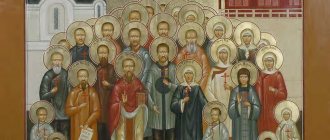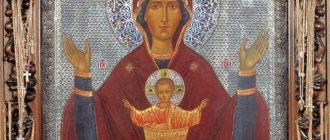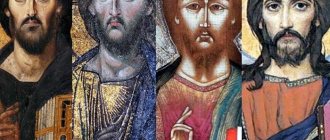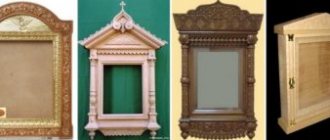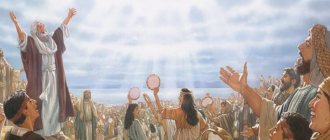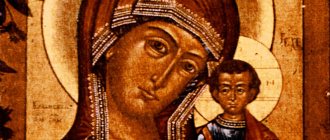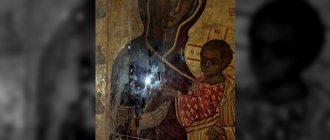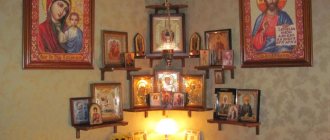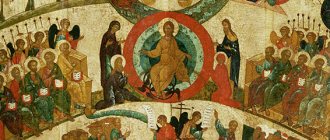Why is icon veneration accepted in Orthodoxy?
The most popular argument that Protestants try to use when denying the veneration of icons is a quote taken from the Bible: no one has ever seen God (John 1:18). “How can you portray God if he is invisible?” - they are indignant. But traditionally, for the sake of their faith, they act cunningly and unwisely. Because a person who knows the Holy Scriptures well will immediately answer that further after this quotation the Gospel of John contains the following words: The only begotten Son, who is in the bosom of the Father, He has revealed (John 1:18).
This is the main argument in defense of icon veneration in Orthodoxy. Holy icons appeared after the coming of God the Son into the world in the flesh. God became incarnate, became visible through His Son, and now nothing prevents us from making His images. This is what St. John of Damascus wrote:
In ancient times, God, incorporeal and without form, was never depicted. Now that God appeared in the flesh and lived among people, we depict the visible God.
Today, icon veneration is a dogma (established truth) of the Orthodox Church, but this was not always the case. At the beginning of the 8th century, Emperor Leo III initiated the persecution of sacred images, prohibited the worship of them, for which the icons were placed so high that people could not reach them.
All this resulted in the iconoclastic heresy, in connection with which the Seventh Ecumenical Council was organized in Nicaea in 787. It was there that the dogma was adopted, which actually “legalized” the veneration of icons, explaining that the honor given to the image goes back to the prototype, and the one who worships the icon worships the hypostasis of the person depicted on it.
What the Bible really says about icons
Protestants call an icon an idol, and the veneration of icons - idolatry. In their criticism of Orthodox icon veneration, they see similarities with paganism as external, and not in essence.
In order to understand what the second commandment warns against, we need to find out: what is an idol and does it differ in any way from an icon? Even with the most superficial analysis, we will find a number of fundamental differences and even polar contradictions between the icon and the idol. What is idolatry? It is not difficult to agree with the following definition: idolatry is the worship as a god of someone or something instead of the true God, using cult images of any kind.
Cult images can be very different in their material and appearance. A departure from God is not any shape, size, color, material, etc., but the fact that it is worshiped instead of God or on an equal basis with God. To accuse the Orthodox of idolatry, one must stubbornly ignore two fundamental provisions of the Orthodox Church: 1) we worship the One God, the Creator of heaven and earth, revealed to us in the Trinity; 2) we do not consider icons or any other products of human hands to be gods or equal to God. And anyone who agrees with the definition of idolatry proposed above has no right to accuse Orthodoxy of this sin.
An idol is a lie (Jer. 51:17), a fiction of man (Acts 17:29). In the religious wanderings of the pagans, which often affected the Jews, a number of fictional mythical characters arose, deified by the pagan peoples. Not completely freed from pagan habits, the Jews demanded that a golden calf be poured out for them, similar to the bull Apis, which they saw in Memphis. Why was this treason? “They turned their hearts to Egypt... and sacrificed to the idol” (Acts 7:39;41), explains the first martyr Stephen. They did not offer prayers to God, but to an idol, and the sacrifice was addressed to him. As the psalmist bitterly notes: “They exchanged their glory for the image of an ox eating grass. They forgot God their Savior, who had done great things in Egypt” (Ps. 105:20-21). Idolatry for the Jews was not just a change in the attributes of worshiping God, it was always a change in the very object of worship. Paganism deified the products themselves, and idols were considered gods, and not at all their images. According to the prophets, the pagans said to the tree: “You are my father” and to the stone: “You gave birth to me”... where are the gods that you made for yourself? (Jer. 2:27,28; Isa. 48:5; 44:9-20), My people question their tree... they have departed from their God (Hos. 4:12), etc. If idols really were only images for the pagans, then these, like many others, the denunciations and reproaches of the prophets would be groundless. They would be more slanderous than accusatory. The Lord, the knower of the heart, knowing the thoughts of idolaters, says that they “question the tree,” and not God before the tree, as, for example, Moses did before the ark.
Orthodox Christians, looking at an icon, do not turn to it, and it is not the wood and paints that are the object of our worship, but the Person depicted on the icon. Painting an image arises from the desire to get closer to the Prototype. And vice versa, the creation of an idol does not come from striving for God, but from His oblivion.
What makes a piece of wood an idol? Her deification. It pushes God Himself into the background or completely replaces Him. The Lord commands Moses: “Make yourself a copper serpent and display it on a banner, and if the serpent bites any person, the one who is bitten will look at him and live” (Num. 21:8). In this example we see an image that serves to save a person. And only when the Jews began to bow to him much later as a deity, calling him Nehushtan, the copper serpent was destroyed by the pious king Hezekiah (2 Kings 18:4). He was destroyed not because he was revered, but because he became deified. Consequently, the second commandment does not prohibit any image, but only that which is deified, replacing God, i.e. idol. A different understanding of the second commandment makes the Bible contradictory.
The nature of this prohibition is related to the question of the one true God. This is the protection of monotheism from all possible impurities and substitutions. And, of course, the Orthodox absolutely agree that these prohibitions warn against idolatry and are ethically valid and real in both the Old and New Testaments.
However, Protestants include too much in this prohibition. They say: all Holy Scripture of the Old and New Testaments condemns the veneration of icons. By this general name they understand all types of images.
But did the Jews really have no images? Moreover, there were sacred images of a purely religious nature. The Lord said: “Do not make for yourself... images of any creeping thing that crawls on the earth” (Deut. 4:8). And He commands: “Make yourself a brass serpent” (Num. 21:8). Animals cannot be depicted, but in a vision Ezekiel was shown a heavenly temple, replete with carvings of cherubim with human and lion faces (Ezek. 41:17-18). The Lord forbids depicting birds, but from Him comes the command to cast cherubim with wings, to make Cherubim on the ark (Ex. 25:8;22), on the walls of the tabernacle (26:1;31), in the inner part of the temple (1 Kings 6, 27), on the doors of the temple (v. 25), on the walls of the temple (2 Chron. 3:7), in the Holy of Holies and on the curtain (10:14). These commands indicate, first of all, the possibility of depicting the spiritual created world through the means of art. It is important to note that in order to make all the accessories of the tabernacle, including the icons of the cherubim, God filled the craftsman, Bezaleel, with His Spirit (Ex. 31:1-11). This was not just decoration of the temple, but religious images, consecrated by God according to His own command: “Take the anointing oil and anoint the tabernacle and everything in it, and consecrate it and all its utensils, and it will be holy” (Ex. 40, 9). Thus, religious images were established for the Jews by the very God who forbade the deification of anything. This is also evidenced by their place in the cult of Israel. Cherubim served as an image of the presence of the glory of the Lord, the ark - an image of the presence of God. Referring to Num. 10:33-36 let's say more - it was the image of God Himself.
None of the prophets reproach the Jews for the sacred images that were in the temple. They forbade making images of “other gods.” Is the image of Christ the image of an idol? If we take into account that, unlike the pagans, we are indifferent to the material from which the icons are made, then in order to continue accusing us of idolatry, it will be necessary to say that we are not the One to whom we should bow. But even the narrowest mind would not dare to assert this.
We must learn to distinguish the sacred from the unholy and the unclean from the pure (Lev. 10:10). And this applies to all aspects of theology and life. There is the tabernacle of David (Acts 15:16) and the tabernacle of Molech (7:43), the cup of the Lord and the cup of demons, the table of the Lord and the table of demons (1 Cor. 10:21). The pagans are deceived when they depict Baal, Astarte, Moloch, Artemis, Perun, etc. They did not exist. They are also mistaken when they deify earthly kings and national heroes. “There is no God besides me” (Isaiah 44:6) says the Lord.
We need to look deeper. The essence of things, their purpose. In the Holy Scriptures, God, angels, man, and virtues and vices are depicted through words, and since everything said about them is true and aims to glorify the name of God, we accept Scripture with all our hearts and souls, for it tells us about great providence God and the mysteries of human salvation. Isn’t that what icons are talking about, conveying meanings with other symbols? By accepting the Bible, we reject the writings of heretics as containing lies, despite their outward similarity. This is how one should reason about sacred images.
Protestants reproach the Orthodox for the fact that, referring to the fact of the Incarnation, they underestimate the prohibitions of the Old Testament. The Lord's incarnation in no way made it permissible to worship false gods or deities. The second commandment was not abolished by the incarnation of the Son of God. The Incarnation made the unimaginable God depictable according to His humanity. There is no point in providing evidence about the possibility of depicting Christ, angels and other spiritual realities. All Protestants depict Christ, the Mother of God, etc. in their magazines, books and posters. The strange thing is that at the same time they prove the impossibility of depicting Christ in any form.
It is possible and necessary to portray Christ. An icon is the same sacred words, clothed in colors, a visual image of what the prophets and apostles preached. The question is, is it permissible to use images during prayer and to show signs of respect in front of the image? Is worship performed before His image acceptable to God?
Protestants base their polemics against icon veneration on the erroneous assumption: idolatry is the worship of the true God using any images.
First, this formulation is not supported by a single passage of Scripture. All the passages cited by them speak of the worship of pagan gods.
Secondly, all the righteous of the Old and New Testaments fall under this ill-conceived definition. Worship the Lord your God (Matthew 4:10), but in the Bible there are many examples of respectful worship of that which is not God in the name of God Himself. So David sings: I worship before Your holy temple (Ps. 137:2). I will worship Your holy temple (Ps. 5:8). I lift up my hands to Your holy temple (Ps. 27:2). Let us go to His habitation, let us worship at the footstool of His feet (Ps. 131:7). Joshua fell on his face before the ark (Joshua 7:6). The Apostle Paul went to Jerusalem to worship (Acts 24:11) and prayed in the temple into a frenzy (22:17). Jacob... bowed down on the top of his staff (Heb. 11:21). So, did they all sin? No. This was worship of the Almighty before the image speaking about Him! As Solomon truly expressed it in his prayer for the temple: when they (the Israelites) feel distress in their hearts and stretch out their hands to this temple, You will hear from heaven, from Your dwelling place, and have mercy (1 Kings 8:38-39) .
Protestants stumbled over the word “worship.” By confusing the two forms of worship, they cast a shadow on the saints of the Old Testament, indirectly accusing them of idolatry. “Worship” as religious self-dedication and trust must be distinguished from “bow” as a physical expression of respect. Otherwise, in order to prohibit bowing in front of icons, one will have to recognize all pious Jews as idolaters.
What was the ark for Israel? He was the object of worship of the true God, the image of God, the image of His gracious presence. “When the ark was taken up on its journey, Moses said: Arise, O Lord, and Your enemies will scatter, and those who hate You will flee from Your face! And when the ark stopped, He said: Return, Lord, to the thousands and thousands of Israel” (Num. 10:35-36). Thinking in a Protestant way, it is impossible not to accuse Moses of idolatry, because he speaks of the Ark of the Covenant as a living person. How should we react to the fact that David galloped with all his might before the Lord (2 Sam. 6:14), i.e. before the ark? In addition, before the ark they brought burnt offerings (1 Kings 3:15), sang (Ps. 137:1-2), burned incense (Exodus 40:26-27), and lit lamps (37:17; 23). It would not be amiss to note that on the ark there were two hammered gold cherubs. The ark was separated by a curtain, on which cherubim were also embroidered (2 Chron. 3:14). The altar stood in front of this veil (Ex. 40:5). Thus, incense was offered in the presence of sacred images. Outwardly, the Israelis are the same pagans. But if you look closely, it is not difficult to see that the performance of all these religious actions with the direct participation of material objects did not at all prevent them from truly worshiping the Creator; on the contrary, it contributed to this. Likewise, censing in front of icons is addressed not to the icons themselves, but to those whose images they show us.
Protestants object that God Himself commanded the creation of the above-described images, and icons are not directly sanctioned by Him, and therefore have no right to exist. But, firstly, in the New Testament there is no sanction for any religious images, but Protestants widely use them. Secondly, God commanded the creation of these images not without reason and purpose, but, first of all, to establish the correct way of worshiping God. Consequently, He sanctioned not just a list of permissible images, but the benefits of their use. Third, the above worship is not prescribed by the Old Testament, but Scripture repeatedly testifies to it as an expression of godliness.
The VII Ecumenical Council determined that sacred images should be everywhere - so that people would remember the Savior more often and call on Him in prayer more often. An icon provokes the birth of prayer in the soul of a believer, and the more images there are that awaken our prayer, the better.
Why did people in the Old Testament turn to Jerusalem and the temple when praying? (1 Kings 8.48; Dan. 6.10). The prayer before the image is addressed to the Prototype and is accepted by Him. It is this movement of the soul directed towards God that makes the image an icon. That is why the Ark of the Covenant was given respectful worship because its presence directed the heart to God and gave rise to prayer. So the icon serves us to give birth to the same feelings.
No one will deny that, even looking at the stars or the beauty of nature, one can glorify the Creator. How numerous are Your works, O Lord! You did everything wisely! (Ps. 103:24). This means that, looking at earthly things, you can sing about Heavenly things! And this visible guide to the Invisible God becomes “an abomination before the face of God” only when people worship the stars and elements instead of God, who created them.
So, we have come to the main question of icon veneration: is veneration accepted before the image by the Prototype Himself, i.e. is there a connection between them? A mother kissing a photograph of her beloved son does not cause disgust among Protestants. After all, she is not pouring out her feelings to photographic paper, but to her son. And the traditional Orthodox formula about the mental ascent from the image to the Prototype in this case is understandable and accepted by Protestants unconditionally.
What does a portrait have in common with the person depicted in it? Same personality. Looking at the portrait, we say: “This is Ivan Ivanovich” and, looking at Ivan Ivanovich himself, we say the same thing. They are not at all united by shape, substance, color, volume, weight or even external data. They are united by identity. They have the same name. And a name is an indicator not of nature, but of personality.
The Bible is also a collection of images taught to us through words. And Protestants are wise enough not to wrap their pies in pages from the Bible. In this case, they recognize the connection between images and prototypes, although even if you look at the Bible (book) the way Protestants look at an icon, then it is nothing more than ordinary paper and paints. Yes, the icon is written in symbols and is incomprehensible to Protestants, but the Bible is written in the same way. And if it is written in symbols incomprehensible to us (in a language incomprehensible to us), then this does not cease to be the Word of God. Likewise, an icon is an image of God, regardless of whether everyone understands this.
If any of the Protestants becomes offended by the fact that someone contemptuously spat on his photograph, he will violate his own conviction in the absolute separation of the image from the prototype, because the insult was inflicted on the paper, the paints, but not on the person depicted on it. And the fact that the spitting person said your name at the same time doesn’t apply to you either, he didn’t spit on you!
Protestants believe that Orthodox Christians idolize icons, serve akathists and prayer services to icons, and worship icons. We do not idolize icons, and therefore we do not serve akathists and prayer services to them, and we do not worship them, but God. The definition: “service and worship of icons” implies a complete lack of connection between the image and the prototype.
And if the Protestants are right and it really doesn’t exist, then the worship of the Ark of the Covenant is nothing more than the worship of the box and the above-mentioned blunders about insulting the image are normal. However, the Word of God says otherwise. God does not shy away from His images. He acts and even works miracles through man-made objects that symbolize Himself.
The ancients, looking at the prototype of the trampling of Satan (the copper serpent), saved themselves from death, and we, prayerfully looking at the image of the Trampled One, are idolaters?! Illogical. Regarding the brass serpent, Protestants object that God then acted through an image because the Israelites had little faith in the invisible. But then we will have to recognize Moses as having little faith. God told him this: I will reveal myself to you and speak to you... in the middle of two cherubim (Ex. 25:22), that is, also through a visible image. It turns out that any Protestant has faith in the invisible stronger than the faith of Moses and David!
Anyone who has read the Old Testament knows about the miracles from the ark. Let us at least remember the fall of the idols in the temple of Dagon (1 Samuel 5:1-12) or the crossing of the Jordan, as once through the Red Sea (Joshua 3:5), the encircling of the ark around Jericho (Joshua 6:5-7) and etc. And how many miracles and healings from icons does Christian history know, from the first centuries to the present day. But for Protestants, miracles from icons are a “sad delusion.” Why do Protestants, like atheists, need to prove that the Church did not “attribute miracles and healings” from icons, but that they actually happen in reality?
We see a reverent attitude towards the image of Christ among the Protestants themselves. Baptists, honoring bread and wine in the rite of breaking bread as symbols, or otherwise: images, signs, of the Body and Blood of Christ, are very sensitive to these symbols. They do not crumble the bread and, eating with wine, mentally ascend to Golgotha or the Last Supper. Thus, the hand-made image of Christ elevates the Baptist to the Prototype. Why do other types of hand-made images evoke directly opposite feelings among Baptists? Shouldn't they reverence the image of Christ in the same way as the image of His atoning sacrifice? Why is the image of the Body and Blood holy, but the image of Christ Himself an idol?
Worship, even a gesture, before an image is so connected with the worship of the Prototype that in the era of iconoclasm, Christians sacrificed their lives, refusing to trample on icons. And the other side: for a Christian it is better to give up his body to be tortured than to worship the image of a false god. It was not the wood and decoration that were so unacceptable (or loved) by the martyrs, but the prototypes that were hidden behind them. The images of false gods belong to the father of lies (John 8:44). The image of the true God (1 John 5:20) is an accessory to the Truth.
We do not blame Baptists for portraying Christ, where necessary, both in His earthly humiliation and in His heavenly glory. It’s only strange to hear from them that this is “impossible” and “unreasonable.” Of course, it is photographically impossible to depict Christ in glory, Who dwells in the unapproachable light (1 Tim. 6:16), but no one sets such a task for themselves. And Baptist artists also paint the image of the risen Christ.
An Orthodox icon aims to depict a person, not external data. Therefore, the accusation that the image on the icon is not similar to the prototype seems absurd to us. The icon does not try to depict either the appearance of the Savior, or, especially, His Divinity. The Orthodox canonical icon places all the emphasis on the Person Who both reveals and preaches. That Person Who is recognizable because he is described in the Bible. And if we ask the question about the reality of the image in the icon, then the answer will be: yes, the image depicted on the canonical icon is true because it corresponds to the image of the Savior, which was taught (depicted) by the apostles through Scripture.
Protestant magazines and posters gravitate towards sensual, photographic images. There is the same difference in the iconography of Orthodox and Catholic. The latter is also keen on sensuality and embellishment. Often Protestants, not being able to distinguish an Orthodox icon from a Catholic one, criticize the Orthodox one, meaning Catholic.
Speaking about the possibility or impossibility of depicting Christ, it should be noted that the mystery of the Incarnation is incomprehensible. And therefore indescribable neither in words nor in colors. What could be partly described in words was described by the apostles, and what could be partly described in paints was written on icons. And therefore, whoever denies the partial depiction of the Incarnation with paints (and the icon of the Mother of God with the eternal Child in her arms expresses precisely this dogma), must also deny the verbal description of the great pious mystery (1 Tim. 3:16), for the word also depicts it very figuratively and superficially.
Orthodox prayer before an image is a prayer addressed to the prototype. The icon does not entertain the eye during prayer. On the contrary, it helps spiritual concentration by blocking the flow of diverse external visual sensations. Therefore, Orthodox Christians do not need to squint their eyes during prayer, as Baptists do. A visible image destroys imagination and fantasies, which also interfere with sober prayer. The dispassion of the Orthodox icon is intended to emphasize the spiritual depth and purity of the person depicted. It creates that prayerful mood that turns our inner eyes to heaven. Standing before the icon of the Savior, the Orthodox prayer book in spirit stands before the Lord Himself. The image does not interfere with prayer, but collects it, raising the spirit and mind not to the image, but to the Image.
An icon, like a word, is one of the means of knowing God, one of the ways of ascent to Him. Therefore, the Orthodox church image (icon) is not limited to only an illustrative function, but also serves for prayerful worship and communication with the Archetype. We raise our minds to the personality, and not to its image. Whether you paint an icon to remind you of the invisible and unimaginable God, you are not creating an idol for yourself. If you imagine God and think that He is like your imagination, you set up an idol for yourself - this is the meaning of the Old Testament prohibition.
How does an icon differ from a simple image?
How does a holy image differ from any other image? The reasons for the veneration of icons cannot be understood without this explanation. Obviously, not only the subject of the image, although they too. A consecrated image cannot be, like a painting, only a source of aesthetic, sensory experience. Therefore, the main purpose of any sacred image is prayer in front of it, and not the decoration of a temple or home.
The iconographic image directs the mind and heart of a person to spiritual contemplation, refers to the invisible, supersensible world. The basis of such an image is always a symbol that connects the external world with the spiritual, invisible. Holy icons have the power of grace emanating from the one who is depicted on them. Therefore, when people pray, they worship not the material itself, the board and the paints, as they like to say, but those who are depicted on them.
Is it possible to be Orthodox but not venerate icons?
Refusal to venerate icons is not as harmless for the Christian worldview as it might seem at first glance.
Firstly, this is a rejection of the Creed in terms of faith in the one, holy, catholic and apostolic Church. Contrasting oneself with the entire Church, which venerates icons, is a clear sign of pride.
Secondly, this is a distorted, heretical interpretation of the Holy Scriptures, contrasting the Old Testament with the New, denying their continuity.
Thirdly, this is a misunderstanding of the dogmatic teaching of the Church.
Fourthly, by denying icon veneration, opponents of sacred images cut off from themselves both the source of Divine Revelation and the means of prayerful communication.
Why pray in front of the image?
However, the question may arise: do you really need holy icons to pray? Is it impossible to live without them? Of course not. The Lord sees and hears us in every place, regardless of whether we pray in front of the image or without it. But nevertheless, in the second case, there is a danger that we may have our own subjective, distorted idea of the Personality of God or a saint.
The human imagination is structured in such a way that it requires the existence of certain visible forms and ideas. And here lies a great danger if we begin to represent something “of our own.” Because of this, it is very easy to fall into spiritual delusion.
Holy icons, painted in accordance with the canons and, as a rule, by people with a heart more purified from passions, are able to protect a person from such a mistake. In a word, if you are not going to pray in front of a holy image, then the main thing is not to try to imagine anything in front of you.
What does it mean to honor the image of God?
It is obvious to true admirers and creators of icons: icon painting is not about portraiture, about illustration. Icon veneration does not come down to kissing icons, censing them, lighting candles, or lighting lamps in front of them. Honoring the image of God in spirit and truth (John 4:24) means for all Christians to strive to recreate Him in themselves and in the world, returning the world to God, deifying it. The main shrine in the world of God is man. In this sense, all Christians should be creators—icon painters and restorers of the image of God. According to the Holy Fathers, “each of us is an icon painter of our own life.” And the connection between the commandment of love for God and neighbor with veneration of the image of God revealed in man, that is, with love for Him, becomes clear. Therefore, the Church does not call artists true icon painters, creators, but the Holy Fathers, who fulfilled these commandments and showed us the image of God in themselves. The responsibility of church artists when painting icons is to be faithful to Tradition, that is, to recreate in themselves the image of God, walking the patristic path, and, as a result, to give the Church and the world the opportunity to contemplate what they themselves have seen. This means accurately revealing the image of God on icons in its entirety, given to the artist in Tradition, of which the iconographic heritage is a part.
When did the very first iconographic images appear?
Despite the fact that the birth of icon painting became possible, as we said, in connection with the event of the Incarnation, in Old Testament times there were also images of ethereal forces. Thus, it is well known that the Ark of the Covenant was decorated with figures of cherubs.
Actually, the very first icon-painted face is considered to be the image that received the name “Savior Not Made by Hands” and was made during the life of Christ, when holy icons had not yet been painted. The history of the face is as follows. A certain king Abgar, who ruled Edessa, fell ill with a terrible disease, black leprosy, from which it was impossible to recover.
He had heard about the miracles that the Savior performed, and sent his artist to Him to make a portrait of Jesus Christ, since the king himself could not get to Him. Avgar believed that this would help him heal. No matter how hard the court artist tried, he could not capture the face of the Savior.
Then Jesus, seeing his desire, asked to bring water, washed his face and wiped it with a handkerchief, after which he handed this handkerchief to the artist. And a miracle happened: a face appeared on the fabric. The second miracle happened in Edessa, when the king, touching this handkerchief, was healed. This legend is another basis for the veneration of icons.
We also know that the first images of the Virgin Mary belong to the brush of the Apostle Luke and were made with Her consent. The Most Holy Virgin herself blessed the painted images with the words: May the grace of the One born of Me and Mine be with these icons!
In early Christian times, known for their brutal persecution of the faithful, a symbolic image of the Savior was common. He was depicted as the Good Shepherd with a lamb in his arms, in the form of a lamb, but most often in the form of a fish. As you know, the last word in Greek sounds like “ichthys”, and is a kind of abbreviation of the words “Jesus Christ the Son of God the Savior”. Similar images are often found on the walls of ancient catacombs.
Such symbolic designs hardly remind us of holy icons. Iconography in the proper sense was born no earlier than the 6th century. The first such images were made in the burning style (encaustic), characteristic of ancient, Hellenistic art.
In this case, the paint was mixed using heated wax. The most famous holy image of the Savior of this period is the face painted on Sinai with the asymmetry characteristic of Hellenism. Until now, this image causes a lot of controversy and discussion among researchers.
To whom are the icons addressed?
The icon is addressed primarily to the Church, to its liturgical and prayer life. But it, being at the same time a mystery and a Christian Revelation, also carries out its service for the world. Nowadays they often talk about the need for the Orthodox Church to preach the Gospel to the whole world. By its appearance to the world, the icon itself is a testimony, it is itself an Orthodox mission. Therefore, wherever there is no conscious trampling of the sacred, where people worship the One True God or at least only strive for true worship of Him, seek Him, the appearance of Orthodox icons as witnesses of the Truth should be welcomed everywhere.
Golden hand of the Virgin Mary
When in the 8th century Byzantium was gripped by iconoclasm, which rejected holy icons, the Monk John of Damascus spoke out against this. He wrote his famous “Words” in their defense. And since John had an amazing gift of speech, and also held an honorable position under the ruler of the capital of Syria, his messages had great persuasive power. For this, the saint soon had to suffer.
Slandered by the Byzantine king through cunning, John of Damascus was severely punished: he was deprived of his right hand. However, after praying in front of the icon of the Most Pure Virgin, his hand miraculously grew back and wrote many more works that defended the veneration of icons. For this miraculous healing, the monk gifted the sacred image with a poured golden hand, by which we recognize the image of the “Three-Handed One” today.
Ancient Russian icons
There is an opinion in the Church that ancient icons are special. It is believed that early Byzantine icons and Russian icons up to and including the 16th century retained intact the foundations that had been laid by tradition in icon painting from the very beginning. Their peculiarity is that they absolutely correspond to their purpose - they open the invisible world and promote prayer. Looking at them, you understand that they are prayer.
Our Lady Hodegetria. Tver. First quarter of the 15th century.
Starting from the 17th century - at least in Russia - Western influence began to penetrate into icon painting. Human figures have become more realistic. Human emotions could be seen more and more often on their faces. It is believed that this goes against the original deep mystical message that has been embedded in icon painting since the first centuries.
Our Lady of Tikhvin. Ural. 19th century.
This applies to icons painted up to the 20th century. Modern icons are painted for the most part with an eye on the original Russian and Byzantine traditions. But, of course, they cannot compare with the ancients. Therefore, among modern icons, copies of ancient images are especially valued.
The wounded face of the Most Pure One
Another event occurred at about the same time in Nicaea. Then the enraged iconoclasts came to the house of a widow and in anger pierced the ancient image of the Mother of God that she kept with a spear. However, they were amazed that blood immediately oozed out from the wound, and they believed. Later, the woman, saving, launched this image across the sea, and it came in due time to Athos. Based on the name of the monastery, the icon received the name Iverskaya. To this day, she protects the monastery from many troubles, being its “Goalkeeper”.
Iveron Icon of the Virgin Mary
The Great Penitential Canon of Andrei of Crete
What is the connection between the Eucharist and icon veneration?
The center, the core of the Church’s ministry is the Liturgy in its eucharistic – thanksgiving and sacrificial – understanding. Everything in the Church is connected with the Eucharist and finds its beginning in it. What is the essential connection between the Eucharist and icon veneration? In the Eucharist, we thank the Lord by sacrificing to Him everything we can from our “I”, that is, perhaps we humble ourselves more completely, we humble ourselves in order to be freed from ourselves. And we accept the Holy Gifts, the Source of true life - the Body and Blood of Christ. But aren't we burying them? Is the Resurrection of Christ taking place in us, which is spoken of both in the rites of the Liturgy and in the preparatory and thanksgiving prayers said by each communicant? In order for the hoped-for resurrection of the dead to happen in reality, this gift and feat of Communion must result and find concrete expression in the gift and feat of revealing the image of God in ourselves, in deification - the return of our iconicity. For this purpose, a person is given the freedom to bear the cross - to live according to God’s plan. To fulfill the divine plan of life, this terrible gift and feat of gaining iconicity, the Holy Gifts are given to us in the sacrament of the Eucharist. By manifesting them in our lives, that is, again thanking God and sacrificing our lives to Him, we demonstrate our veneration of icons as veneration of the Prototype of God (which is what is commanded to us - the honor of the image ascends to the Prototype). By honoring the Prototype, we commune, recreate, keep It within ourselves and display It in the world of God. And if in icon veneration we really worship Christ, then in the Sacrament of the Eucharist we accept Christ as real food. At the same time, it is vitally important to exclude the consciousness of the naturalistic nature of what is happening and to reveal the reality of man’s communion with God by the power and influx of the Holy Spirit. Thus, the icon is a visible correspondence to the reality of the glorified Body of Christ - the Eucharist. This correspondence of the icon to our main sacrament distinguishes it from any other artistic creation. What the Holy Gifts are is real, but mysterious, the image clearly shows.
In what religions do holy icons still exist?
Of the Christian denominations, Catholics also have iconographic images. True, Western Christians prefer more sensual, picturesque images, as well as stained glass and mosaics. Sculptural statues of saints are especially common in Catholicism. Protestants do not recognize iconographic images at all. Actually, like Islamists and Jews.
There is some semblance of holy images in Hinduism and Tibetan Buddhism. In the latter they bear their own name - tanka. However, both in Buddhism and Hinduism, they, of course, have nothing in common with Orthodox icons.
Doesn't the practice of icon veneration violate the 2nd commandment of the Old Testament?
The Second Commandment of the Old Testament sounds like this: “You shall not make for yourself an idol or any image; do not worship them or serve them.” This commandment is directed against idolatry, not icon veneration, and should be taken in context, and not in isolation from the 1st Commandment, “I am the Lord your God, and there are no other gods besides Me.”
A little history. The Old Testament, God's chosen people, to whom these commandments were originally given, were the custodians of faith in one God. He was surrounded on all sides by pagan peoples and tribes. To warn the Jews not to under any circumstances adopt pagan beliefs in idols (worship of animals, deification of material objects), God establishes this commandment.
You can remember the meaning of the word “idol” - it is a sculptural image of a pagan deity. For us, this word began to have a broader meaning - an object of adoration.
This commandment was given in the Old Testament in opposition to pagan idols and emphasized that God is indescribable, indescribable. We already live in the times of the New Testament, when the Incarnation opened up the possibility of icon veneration. God became a man (incarnated) and this allows us to depict him in the image of a man.
Only God is omnipresent
Theologians explain that the prayers simultaneously emanating from many thousands of Christians on the planet can only be heard by the Almighty, for only he is omnipresent. Only the creator is able to be in all places at the same time and listen to the requests of each person individually. Neither the holy saints nor the Virgin Mary can do this. After all, they are in one place - in heaven.
And if you previously turned to the Mother of God or to the saints, because you didn’t know that you couldn’t do this, the holy fathers urge you to ask God for forgiveness and pray only to him. After all, both the Virgin Mary herself and the holy saints did this.
Found a violation? Report content
